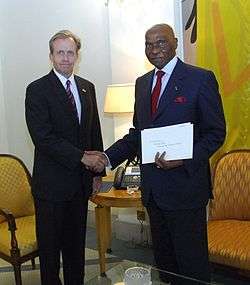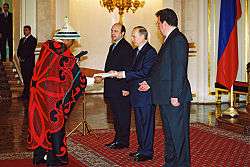Letter of credence



A letter of credence is a formal letter, usually sent by one head of state to another, that formally grants diplomatic accreditation to a named individual to be the sending country's ambassador in the receiving country. A letter of recall is the opposite, recalling an ambassador, either as a means of diplomatic protest (see letter of protest) or because the diplomat is being replaced by another envoy. Diplomatic letters are generally written in French (the lingua franca of diplomacy), unless the countries share the same official language.
Letters of credence are presented personally to the receiving head of state by ambassador-designates in a formal ceremony. Letters serve as the most traditional and universal forms of Diplomatic credentials.[1] Until their credentials are accepted, an ambassador-designate does not formally assume diplomatic status, including the possession of diplomatic immunity. In practice, however, they are almost invariably accepted, as both states will have informally discussed the issue in advance and sorted out any problems.
In parliamentary democracies, heads of state or their representatives accept or reject diplomatic credentials on the basis of advice (binding instructions to the head of state) from the government. Often, a minister in the government or in cabinet will attend (be present with) the head of state at the actual ceremony, to symbolize the fact that the acceptance of the credentials is on the basis of government advice.
When two countries maintain relations at the chargé level, the letter of credence will be written by the foreign minister of the sending state, and addressed to the foreign minister of the receiving state. The chargé will also formally present his credentials to the foreign minister.[2] The head of state is neither addressed nor presented with the credentials, symbolizing the lower level of diplomatic relations between the countries.
References
| Wikimedia Commons has media related to Letters of credence. |
- ↑ "Ambassador's credentials". The Official Website of The British Monarchy. Retrieved October 20, 2015.
- ↑ U.S. Department of State (1897). Instructions to the Diplomatic Officers of the United States. Washington, DC. pp. 1–5.
| ||||||||||||||||||||||||||||||||||||||||||||||||||||||||||